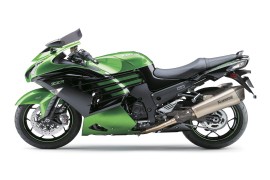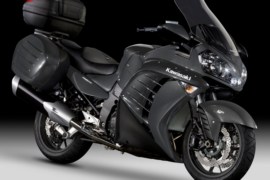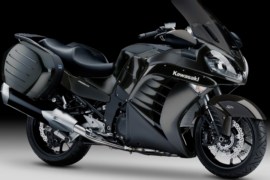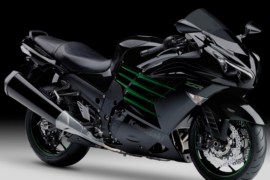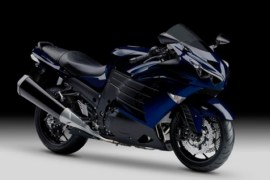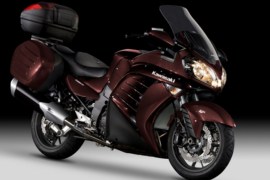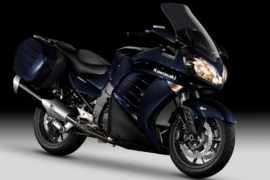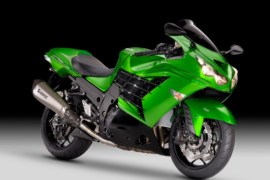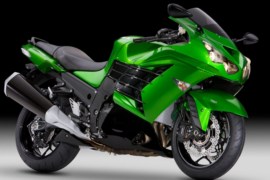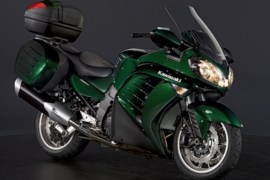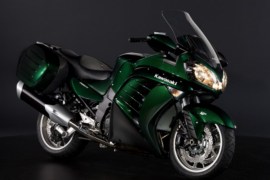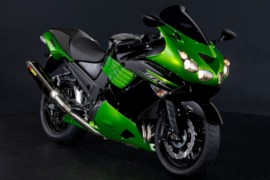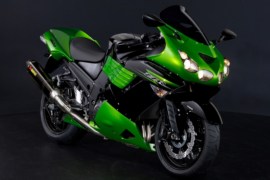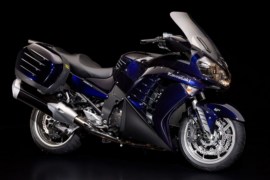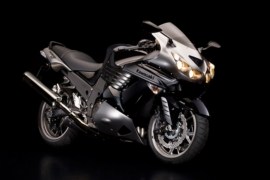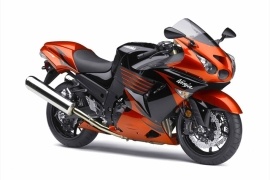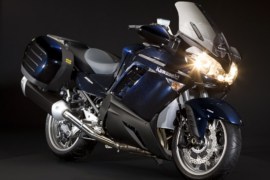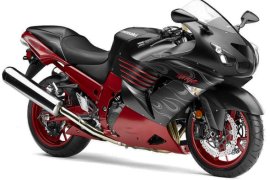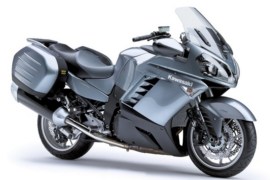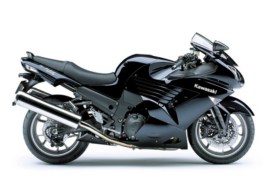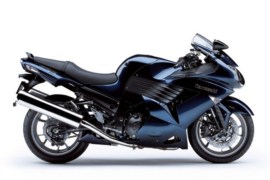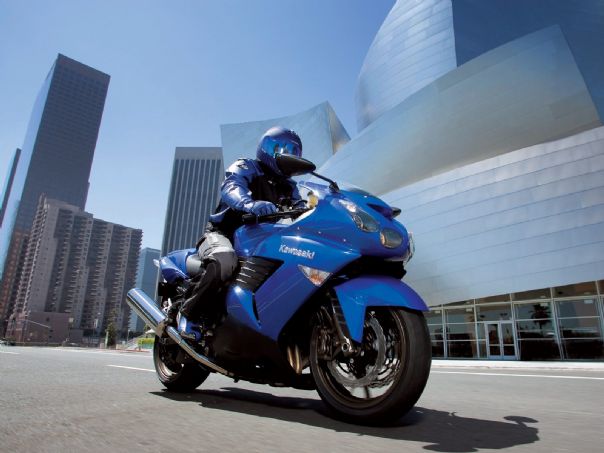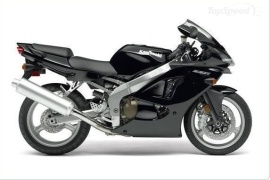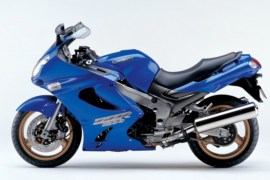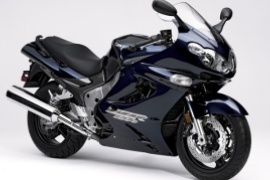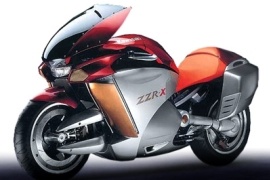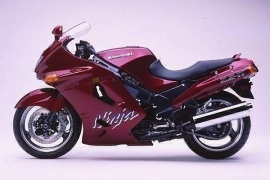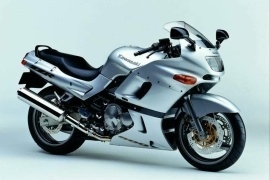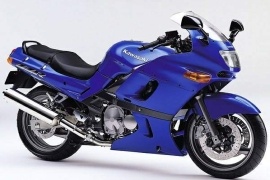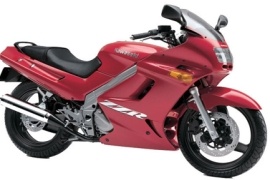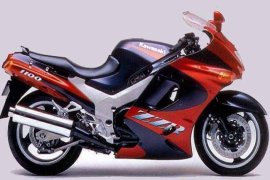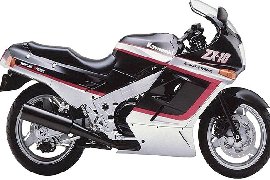KAWASAKI ZZR Models/Series Timeline, Specifications & Photos
First production year: 1988
The Kawasaki ZZR1400, also known as the Ninja ZX-14 and ZX-14R was a sports motorcycle first presented at the 2005 Tokyo Motor Show and released into the world in 2006 as a replacement for the Kawasaki ZZ-R1200.
At its release, the 2006 ZZR1400 was Kawasaki's most powerful sports motorcycle, capable of accelerating from 0-100 kph (0-60 mph) in only 2.5 seconds. Also, due to an agreement between major Japanese and European motorcycle manufacturers, the bike's top speed was electronically limited to 299 kph (186 mph).
In 2016, the Japanese motorcycle manufacturer launched the Kawasaki ZZR1400 Performance Sport, a sports machine representing an intoxicating blend of engineering, style, and performance.
The bike featured an aggressive appearance with standard features, such as a full fairing, a tinted windscreen, a one-piece dual seat with a passenger grab rail, a dual exhaust system with a silencer on each side, and Y-shaped five-spoke aluminum wheels.
The bike packed a 43 mm fully adjustable inverted telescopic fork on the front and a fully adjustable Ohlins shock absorber on the rear, delivering excellent suspension performance and a comfortable riding experience.
As for the power figures, the 2016 Kawasaki ZZR1400 Performance Sport had its soul brought to life by a 1,441cc four-stroke four-cylinder liquid-cooled engine that delivered an output power of 200 hp with a peak force at 10,000 and 163 Nm (120 lb-ft) torque at 7,500 rpm.
In 2012, alongside the base model, the Japanese motorcycle manufacturer launched the Kawasaki 1400GTR Grand Tourer, a sport-touring motorcycle that followed the exceptional trend set by the previous model, fitted with many comfort-oriented accessories without affecting performance.
The 2012 Grand Tourer had a paint protection three-piece gel-resin tank pad and water-resistant interior bags to keep everything tidy and ready to go in an instant. It was also equipped with a GPS bracket for mounting the rider's favorite navigation system.
Besides the side-mounted generous panniers, the bike was fitted with a 47-liter color-matched top case, large enough to accommodate two full-face helmets and an integrated passenger backrest for more comfort.
The 2012 Kawasaki 1400GTR Grand Tourer had installed a 1,352cc four-stroke four-cylinder liquid-cooled engine underneath its armor, fed by an electronically controlled fuel injection system, boasting 155 hp with a peak force at 8,800 rpm and 136 Nm (100 lb-ft) torque at 6,200 rpm.
The Touring motorcycle was built around a monocoque pressed aluminum frame with a 43 mm adjustable inverted telescopic fork on the front and a fully adjustable shock absorber on the rear, offering an excellent suspension performance and a comfortable riding experience.
As for the stopping power, the bike packed two 310 mm semi-floating petal discs with four-piston calipers on the front wheel and a 270 mm petal disc with dual-piston calipers on the rear wheel, offering excellent braking performance.
The Kawasaki 1400GTR was a sport-touring motorcycle that debuted in 2007 to replace the Kawasaki Concours (GTR1000). The 1400GTR was also known as Concours 14 or ZG1400 in some markets and was based on the ZX-14 platform.
In 2012, the Japanese motorcycle manufacturer launched the Kawasaki 1400GTR, a sport touring machine that received two modifications: redesigned front rotors for a smaller carrier and handle warping, and the bike's wheels painted black instead of silver.
Besides that, the 2012 motorcycle featured the same specifications as the previous model, with standard features, such as a full fairing, a smoked windscreen, a one-piece dual seat, side-mounted hard panniers, and black-finished five Y-shaped spoke wheels.
The bike was still built on a monocoque pressed aluminum frame with a 43 mm adjustable inverted telescopic fork on the front and a fully adjustable bottom-link uni-trak gas-charged shock absorber on the rear, offering excellent handling.
The braking power was achieved by two semi-floating petal discs tied to four-piston calipers on the front wheel and a 270 mm petal disc with a dual-piston caliper on the rear wheel, providing excellent stopping performance.
As for the power figures, the 2012 Kawasaki 1400GTR had its heartbeat set by a 1,352cc four-stroke four-cylinder liquid-cooled engine that delivered an output power of 155 hp with maximum strength at 8,800 rpm and 136 Nm (100 lb-ft) torque at 6,200 rpm.
In 2012, the Japanese motorcycle manufacturer launched the Kawasaki ZZR1400 Special Edition, a sports motorcycle that featured several extra technical enhancements, offering more information to the rider.
The Instrument panel was richer than before, including a fuel gauge, a gear position indicator, an odometer, a clock, and a dual trip meter. In addition, it featured numerous modes, such as current and average fuel consumption, range, battery voltage, and an external air temperature sensor, all accessible from handlebar-mounted buttons.
In the aesthetic department, the bike was equipped with standard features, such as a full fairing, a tinted windscreen, a one-piece dual seat with a passenger grab handle, a dual exhaust system with a silencer on each side, and lightweight five Y-shaped spoke wheels.
Underneath its fuel tank, the 2012 Kawasaki ZZR1400 Special Edition had installed a 1,441cc four-stroke four-cylinder liquid-cooled engine fed by an electronic fuel injection system, boasting 200 hp with a peak force at 10,000 rpm and 163 Nm (120 lb-ft) torque at 7,500 rpm.
The bike's engine was enclosed in a monocoque aluminum frame with a 43 mm fully adjustable inverted telescopic fork on the front and a fully adjustable bottom-link uni-trak gas-charged shock absorber on the rear, delivering excellent suspension performance and handling.
As for the braking power, the bike's wheels were fitted with two 310 mm semi-floating discs coupled to four-piston calipers on the front and a 250 mm petal disc with dual-piston caliper on the rear, offering excellent stopping power.
The Kawasaki ZZR1400 was first presented at the 2005 Tokyo Motor Show and released publicly in 2006. The bike was part of the Ninja series in Kawasaki's range and was their most powerful sports machine.
It replaced the Kawasaki ZZ-R1200 and could accelerate from 0-100 kph (0-60 mph) in only 2.5 seconds. In addition, the bike was electronically limited to a top speed of 299 kph (186 mph).
In 2012, the Japanese motorcycle manufacturer launched the Kawasaki ZZR1400, a sports machine that received a second-generation revision with an "R" designation and a larger displacement for more power.
Also, the bike featured two variable power modes, Kawasaki Traction Control (KTC) and an ignition-management system borrowed from the Kawasaki ZX-10 model. Besides visual modifications, incremental chassis changes, and revised suspension internals, the bike also received a slipper clutch for the first time.
In the performance department, the 2012 Kawasaki ZZR1400’s four-stroke, four-cylinder liquid-cooled engine featured internal changes, boosting it to a 1,441cc displacement and delivering more power than the previous model, such as 200 hp at 10,000 rpm and 163 Nm (120 lb-ft) torque at 7,500 rpm.
In the braking department, the bike retained the same braking system as the previous model, with two 310 mm semi-floating petal discs coupled to four-piston calipers on the front wheel and a 250 mm petal disc tied to a dual-piston caliper on the rear wheel.
The Kawasaki 1400 GTR, also known as the Concours 14 or ZG-1400 in different markets, was a sport-touring bike introduced by the Japanese motorcycle manufacturer in 2007 as a replacement for the original GTR 1000 model.
In 2012, Kawasaki launched the 1400 GTR Grand Tourer, one of the best choices for those riders that were looking for a sporty yet comfortable grand tourer, which provided a spacious 47-liter storage top case, a passenger backrest pad and a color-matched cover, and spacious, rigid, and water resistant interior bags.
In the technical department, the grand tourer motorcycle featured an Economical Riding Indicator that popped out on the LCD when the optimal fuel efficiency was achieved, a second-generation Kawasaki Advanced Coactive-Braking Technology (K-ACT) ABS that enabled controlled, balanced braking performance, and Kawasaki Traction Control (KTRC) system that ensured smooth riding on slippery surfaces or various riding conditions.
As for performance, the 2012 Kawasaki 1400 GTR Grand Tourer was powered by a 1,352cc four-stroke four-cylinder liquid-cooled fuel-injected engine that delivered an output power of 155 hp with a peak at 8,800 rpm and 136 Nm (102 lb-ft) of torque available at 6,200 rpm.
In addition, the bike featured a 70 mm taller electrically adjustable windshield that reduced the amount of airflow blowing the rider's helmet and wider at the top for less wind to the rider's shoulders.
In 2011, the Japanese motorcycle manufacturer launched the Kawasaki 1400GTR, a sport-touring motorcycle with the same visual, technical, and performance specifications as the previous model, except for the redesigned front rotors and ABS, which became standard.
The Kawasaki 1400GTR was a sport-touring motorcycle made by Kawasaki from 2007, replacing the Kawasaki GTR1000. The GTR1400, also known as the Concours 14 or ZG1400, was based on the ZX-14 platform.
In the visual department, the bike retained the same appearance as the previous model, with a full fairing, a tall windscreen, a one-piece dual seat, side-mounted color-matched panniers, a dual exhaust system with a silencer on each side, and five Y-shaped spoke aluminum wheels.
In the suspension department, the bike packed a 43 mm adjustable inverted telescopic fork on the front and a fully adjustable bottom-link uni-trak gas-charged shock absorber on the rear, offering excellent handling capabilities.
As for the braking power, the bike's wheels were fitted with two 310 mm petal discs coupled to four-piston calipers on the front and a 270 mm petal disc with a dual-piston caliper on the rear, providing excellent stopping power.
The 2011 Kawasaki 1400GTR had installed underneath its full fairing a 1,352cc four-stroke four-cylinder liquid-cooled engine that delivered an output power of 155 hp at 8,800 rpm and 136 Nm (100 lb-ft) torque at 6,200 rpm.
The Kawasaki ZZR1400 was a sports bike part of the Ninja series in Kawasaki's range. The bike was presented at the Tokyo Motor Show and was also known as the Ninja ZX-14 or ZX-14R. It was released as a replacement for the Kawasaki ZZ-R1200.
At its release, the Kawasaki ZZR1400 was the most powerful sports motorcycle in the Kawasaki range, accelerating from 0-100 kph (0-60 mph) in only 2.5 seconds. Also, the bike's top speed was electronically limited at 299 kph (186 mph).
In 2011, the Japanese motorcycle manufacturer launched the Kawasaki ZZR1400 Performance, basically a base model with several modifications that offered a niftier look and top-end accessories.
The bike was fitted with a street-legal race track performance Akrapovic slip-on exhaust muffler, delivering a sportier appearance and sound. Also, the bike was equipped with a passenger seat cover and a tinted windscreen.
The bike was built on the same monocoque aluminum frame as the standard model, with a 43 mm fully adjustable inverted telescopic fork on the front and a fully adjustable bottom-link uni-trak gas-charged shock absorber on the rear.
Underneath its armor, the 2011 Kawasaki ZZR1400 Performance had installed a 1,352cc four-stroke four-cylinder liquid-cooled engine fed by an electronically controlled fuel injection system, boasting 190 hp at 9,500 rpm and 154 Nm (114 lb-ft) torque at 7,500 rpm.
Presented at the 2005 Tokyo Motor Show, the Kawasaki ZZR1400 entered the sports bike world in 2006. At its release, the bike was part of the Ninja series in Kawasaki's range and was their most powerful sports machine.
The bike replaced the Kawasaki ZZ-R1200 and was capable of accelerating from 0-100 kph (0-60 mph) in only 2.5 seconds. In addition, the bike's top speed was limited to 299 kph (186 mph) due to an agreement between major European and Japanese motorcycle manufacturers.
In 2011, the Japanese motorcycle manufacturer launched the Kawasaki ZZR1400, a sports motorcycle fitted with standard features, such as a full fairing, a small windscreen, a one-piece dual seat with a passenger grab handle, a dual exhaust system with a silencer on each side, and lightweight aluminum wheels.
The bike's suspension system comprised a 43 mm inverted, fully adjustable telescopic fork on the front and a fully adjustable gas-charged bottom-link uni-trak shock absorber on the rear, providing excellent handling.
The braking power was handled by two 310 mm semi-floating discs tied to four-piston calipers on the front wheel and a 250 mm petal disc with a dual-piston caliper on the rear wheel.
As for the power figures, the 2011 Kawasaki ZZR1400 had its soul brought to life by a 1,352cc four-stroke four-cylinder liquid-cooled engine fed by a fuel injection system, boasting 193 hp at 9,500 rpm and 155 Nm (114 lb-ft) torque at 7,500 rpm.
First released in 2007, the Kawasaki 1400GTR was a sport-touring motorcycle based on the ZX-14 platform that replaced the original GTR1000 (Concours) manufactured from 1986 to 2006. The bike was also known as the Concours 14 or ZG1400.
In 2010, alongside the standard model, the Japanese motorcycle manufacturer launched the Kawasaki 1400GTR Grand Tourer, which packed the same specifications as the base model but with additional touring-oriented accessories for more comfortable and enjoyable journeys.
In addition to the generous panniers, the Kawasaki Grand Tourer was equipped with a 47-liter color-matched top case that accommodated two full-face helmets and featured an integrated passenger backrest for more comfortability.
In the performance department, the bike delivered the same specifications as the standard model, with a1,352cc four-stroke four-cylinder liquid-cooled engine managed by a fuel injection system, providing an output power of 155 hp with a peak force at 8,800 rpm and 136 Nm (100 lb-ft) torque at 6,200 rpm.
The sport touring machine was built on a monocoque pressed-aluminum frame with a 43 mm inverted adjustable telescopic fork on the front and a bottom-link uni-trak gas-charged shock absorber on the rear, delivering excellent suspension performance and handling.
The braking power was handled by two 310 mm semi-floating discs coupled to four-piston calipers on the front wheel and a 270 mm petal disc with a dual-piston caliper on the rear wheel.
The Kawasaki 1400GTR was a sport-touring motorcycle manufactured by Kawasaki from 2007, replacing the Kawasaki GTR1000. The bike, also known as the Concours 14 or ZG1400, was based on the ZX-14 platform.
In 2010, the Japanese motorcycle manufacturer launched the Kawasaki 1400GTR, a sport-touring motorcycle that featured several significant modifications in the visual, technical, and performance departments.
The 2010 model came with a KTRC traction control, K-ACT ABS with brake assist, and linked brakes that were optional in some countries and standard in others. These updates enhanced its handling capabilities and added more safety.
The bodywork was also revised to improve engine cooling and minimize engine heat blown to the rider, 40 mm higher mirrors, a redesigned dashboard, a larger windscreen with memory functions, variable heated grips, an optional Fuel Economy Assistance Mode, and an Economical Riding Indicator.
Other changes included the previous tank storage replaced by a locking glovebox in the left fairing, a new exhaust cap, the two-color seat replaced with a single-color seat, a white instrument panel backlight, and fully painted rear panniers.
As for the power figures, the Kawasaki 140GTR had its heartbeat set by a 1,352cc four-stroke four-cylinder liquid-cooled engine fed by a fuel injection system, boasting 155 hp at 8,800 rpm and 136 Nm (100 lb-ft) torque at 6,200 rpm.
The Kawasaki ZZR1400 was a sports motorcycle part of the Ninja series in Kawasaki's range, also known as the Ninja ZX-14 or ZX-14R. The bike was introduced at the 2005 Tokyo Motor Show and released in 2006 as a replacement for the ZZ-R1200 model.
The ZZR1400 was Kawasaki's most powerful sports motorcycle, accelerating from 0-100 kph (0-60 mph) in only 2.5 seconds. Also, the top speed was electronically limited to 299 kph (186 mph).
In 2010, the Japanese motorcycle manufacturer launched the Kawasaki ZZR1400 Performance, a sports motorcycle that featured several improvements compared to the standard model.
The Performance version was fitted with Akrapovic high-performance exhaust mufflers in a carbon or titanium look, offering a race-ready performance boost. Also, the silencers were street-legal and enhanced the bike's sporty appearance.
In addition, the Performance model came with a sporty passenger seat cover, delivering a sportier look, a special edition tinted windscreen, a seff-adhesive tank pad, and two side pads in a carbon fiber look.
As for performance, the 2010 Kawasaki ZZR1400 Performance had its soul brought to life by a 1.352cc four-stroke four-cylinder liquid-cooled engine that delivered an output power of 193 hp at 9,500 rpm and 155 Nm (114 lb-ft) torque at 7,500 rpm.
The braking performance was achieved by two 310 semi-floating petal discs with four-piston calipers on the front wheel and a 250 mm petal disc with a dual-piston caliper on the rear wheel.
Presented at the 2005 Tokyo Motor Show and released in 2006, the Kawasaki ZZR1400, also known as the Ninja ZX-14 or ZX-14R, was the most powerful sports machine in Kawasaki's range, replacing the ZZ-R1200.
The 2006 ZZR1400 could accelerate from 0-100 kph (0-60 mph) in only 2.5 seconds. In addition, the bike's top speed was electronically limited at 299 kph (186 mph) due to an agreement between major Japanese and European motorcycle manufacturers.
In 2010, the Japanese motorcycle manufacturer launched the Kawasaki ZZR1400, an aggressive-looking machine fitted with standard features, such as a full fairing with a medium-sized windscreen, a one-piece dual seat with a pillion grab handle, a dual exhaust system with a muffler on each side, and lightweight five Y-shaped spoke wheels.
In the handling department, the bike packed a 43 mm inverted, fully adjustable telescopic fork on the front and a bottom-link uni-trak fully adjustable shock absorber on the rear fitted on an aluminum monocoque frame, offering excellent handling capabilities.
The bike's wheels were fitted with two 310 mm semi-floating petal discs coupled to four-piston calipers on the front and a 250 mm petal disc with a dual-piston caliper on the rear, delivering excellent stopping performance.
As for the power figures, the 2010 Kawasaki ZZR1400 had its soul brought to life by a 1,352cc four-stroke four-cylinder liquid-cooled engine that delivered 193 hp at 9,500 rpm and 155 Nm (114 lb-ft) torque at 7,500 rpm.
The Kawasaki 1400GTR was a sport-touring motorcycle, also known as the Concours 14 or ZG1400 in several markets. The bike was manufactured from 2007 when it replaced the GTR1000 model, and continued production until 2022.
In 2009, the Japanese motorcycle manufacturer launched the Kawasaki 1400GTR, a sport-touring motorcycle that retained the same engine and chassis as the 2008 model, delivering the same technical, visual, and performance specifications.
In the visual department, the motorcycle had standard features, such as a full fairing with a large windscreen, a one-piece dual seat, a small luggage rack, side-mounted hard panniers, and lightweight aluminum wheels.
The bike's suspension system comprised a 43 mm inverted and adjustable telescopic fork on the front and a bottom-link uni-trak gas-charged adjustable shock absorber on the rear, offering excellent suspension performance and handling.
The braking performance was handled by two 310 mm semi-floating petal discs with four-piston calipers on the front wheel and a 270 mm disc with a dual-piston caliper on the rear wheel, providing excellent stopping power.
As for the power figures, the 2009 Kawasaki 1400GTR had installed a 1,352cc four-stroke four-cylinder liquid-cooled engine that delivered an output power of 155 hp with a peak force at 8,800 rpm and 136 Nm (100 lb-ft) torque at 6,300 rpm.
The bike's power was transferred to a six-speed manual transmission with a wet multi-disc clutch and sent to the rear wheel through a final shaft drive, pushing the motorcycle to a top speed of 254 kph (158 mph).
In 2009, alongside the standard model, the Japanese motorcycle manufacturer launched the Kawasaki ZZR1400 ABS, a sports motorcycle with the same package as the standard model but with an additional safety feature. As the name says, the bike was fitted with Anti-Lock Braking System (ABS).
In the visual department, the motorcycle was fitted with standard features, such as a full fairing with a medium-sized windscreen, a one-piece dual seat with a pillion grab handle, a dual exhaust system with a muffler on each side, and lightweight five Y-shaped spoke wheels.
The bike was built on a monocoque aluminum frame with a 43 mm inverted, fully adjustable telescopic fork on the front and a bottom-link uni-trak fully adjustable shock absorber on the rear, offering excellent handling capabilities.
As for the braking power, the bike was fitted with two 310 mm semi-floating petal discs coupled to four-piston calipers on the front wheel and a 250 mm petal disc with a dual-piston caliper on the rear wheel. The braking performance was enhanced by ABS, offering more safety and a shorter stopping distance.
In the performance department, the 2009 Kawasaki ZZR1400 ABS had its heartbeat set by a 1,352cc four-stroke four-cylinder liquid-cooled engine managed by a fuel injection system, delivering 193 hp at 9,500 rpm and 155 Nm (114 lb-ft) torque at 7,500 rpm.
The Kawasaki ZZR1400, also known as the Ninja ZX-14 and ZX-14R in other markets, was a sports bike part of the Ninja series in Kawasaki's range. The bike debuted in 2006, replacing the ZZ-R1200 model, and was manufactured until 2022.
At its release, the ZZR1400 model was the most powerful sports bike in Kawasaki's range, with 0-100 kph (0-60 mph) acceleration in only 2.5 seconds. In addition, the bike's top speed was electronically limited to 299 kph (186 mph).
In 2009, the Japanese motorcycle manufacturer launched the Kawasaki ZZR1400, a sports machine equipped with standard features, such as a full fairing with a medium-sized windscreen, a single seat with a passenger seat cover, a dual exhaust system with a silencer on each side, and lightweight aluminum wheels.
As for power, the 2009 Kawasaki ZZR1400 had its soul brought to life by a 1.352cc four-stroke four-cylinder liquid-cooled engine fed by a fuel injection system, delivering 190 hp at 9,500 rpm and 154 Nm (114 lb-ft) torque at 7,500 rpm.
The power produced by the engine was transferred to a six-speed manual gearbox with a wet multi-plate clutch and sent to the rear wheel through a final chain drive, pushing the machine to a top speed of 304 kph (189 mph).
As for braking performance, the bike's wheels were fitted with two 310 semi-floating petal discs coupled to four-piston calipers on the front and a 250 mm disc with a dual-piston caliper on the rear.
The Kawasaki 1400GTR, also known as the ZG1400 or Concours 14, was a sport-touring motorcycle based on the ZX-14 platform, replacing the original GTR100 (Concours) manufactured from 1986 to 2006.
The bike's name, "Concours," came from a gathering of prestigious machines in an elegance contest, like the French Concours d'Elegance. The bike combined the racing and touring worlds with excellent racing performance and touring comfort.
In 2008, the Japanese motorcycle manufacturer launched the Kawasaki 1400GTR, a sport touring machine loaded with many convenient features, such as a tire pressure sensor, a maintenance-free shaft drive, ABS, an adjustable suspension system, an electric-adjustable windscreen, and an easy-to-read instrument panel.
Also, the 1400GTR model was fitted with many touring-oriented features, including a 12V power socket, a fuel tank storage compartment, a sculpted seat, a 22-liter (6 gallons) fuel tank, and easy-detachable color-matched panniers.
In the performance department, the 2008 Kawasaki 1400GTR had installed underneath its fuel tank a 1,352cc four-stroke four-cylinder liquid-cooled engine that delivered an output power of 155 hp at 8,800 rpm and 136 Nm (100 lb-ft) torque at 6,200 rpm.
As for handling, the bike was built on a monocoque pressed-aluminum frame with a 43 mm inverted adjustable telescopic fork on the front and a bottom-link uni-trak gas-charged shock absorber on the rear, offering excellent handling.
In 2008, the Japanese motorcycle manufacturer launched the Kawasaki ZZR1400 ABS, a sports motorcycle that carried on the acclaimed heritage of the previous models, with improved ergonomics for a more comfortable riding experience.
The bike's fuel tank was remodeled for a narrower profile, while the slim design of the monocoque chassis allowed the rider to keep its knees closer together for better protection against wind.
Also, the front cowl featured a low-drag and improved aerodynamic design, housing highly efficient headlights and a newly redesigned instrument cluster that used CAN connectors, displaying more data on the screen with fewer wires hanging.
The bike packed standard features in the aesthetic department, such as a full fairing with redesigned headlights, a small windscreen, a one-piece dual seat with a passenger grab handle, a dual exhaust system with a silencer on each side, and lightweight aluminum wheels.
The 2008 Kawasaki ZZR1400 ABS had installed a 1,352cc four-stroke four-cylinder liquid-cooled engine underneath its fuel tank, fed by a fuel injection system, boasting 193 hp at 9,500 rpm and 155 Nm (114 lb-ft) torque at 7,500 rpm.
The bike's braking performance was handled by two 310 mm semi-floating discs coupled to four-piston calipers on the front wheel and a 250 mm petal disc with a dual-piston caliper on the rear wheel, offering excellent stopping power. The braking performance was enhanced by an Anti-Lock Braking System (ABS), providing more safety and a shorter stopping distance.
The Kawasaki ZZR1400 was a sports bike part of the Ninja series in Kawasaki's range. The bike was introduced at the 2005 Tokyo Motor Show and was also known as the Ninja ZX-14 or ZX-14R.
At its release, the bike was the most powerful motorcycle in Kawasaki's range, capable of accelerating from 0-100 kph (0-60 mph) in only 2.5 seconds. Also, the bike's top speed was electronically limited to 299 kph (186 mph) due to an agreement between major European and Japanese motorcycle manufacturers.
In 2008, the Japanese motorcycle manufacturer launched the Kawasaki ZZR1400 / ZX-14R Special Edition, a unique model characterized as the fastest motorcycle ever and made only for the American market.
In the visual department, the bike had standard features, such as a full fairing with a medium-sized windscreen, a single seat with a passenger seat cover, a dual exhaust system with a silencer on each side, and red-finished lightweight aluminum wheels.
Underneath its armor, the 2008 Kawasaki ZZR1400 / ZX-14R Special Edition had installed a 1,352cc four-stroke liquid-cooled four-cylinder engine that delivered an output power of 190 hp with a peak force at 9,500 rpm and 153 Nm (113 lb-ft) torque at 7,500 rpm.
The braking performance was handled by two 310 mm semi-floating petal discs with four-piston calipers on the front wheel and a 250 mm petal disc with a dual-piston caliper on the rear wheel, providing excellent braking power.
In 2007, the Japanese motorcycle manufacturer launched the Kawasaki 1400 GTR, a more touring-oriented sports motorcycle with rich instrumentation, a pressure sensor, a 12V socket, ABS, an adjustable suspension, and an electric windscreen.
The bike was introduced in 2007 and was based on the ZX-14 platform. It was intended to replace the Kawasaki GTR1000 (Concours), manufactured from 1986 to 2006.
In the aesthetic department, the touring motorcycle was fitted with standard features, such as a full fairing with two large headlights, an adjustable windscreen, a one-piece dual seat with passenger grab handles, side-mounted hard panniers, a four-into-one exhaust system with the silencer mounted on the right side, and lightweight aluminum wheels.
Suspension-wise, the big bike was fitted with a 43 mm inverted adjustable telescopic fork on the front and a bottom-link uni-trak gas-charged adjustable shock absorber on the rear, offering excellent handling and a comfortable riding experience.
In the braking department, the bike packed two 310 mm discs coupled to four-piston calipers on the front wheel and a 270 mm disc with a dual-piston caliper on the rear wheel, delivering excellent stopping power.
As for the power figures, the 2007 Kawasaki 1400GTR had installed a 1,352cc four-stroke four-cylinder liquid-cooled engine with a fuel injection system in charge, boasting 155 hp at 8,800 rpm and 136 Nm (100 lb-ft) torque at 6,200 rpm.
The Kawasaki ZZR1400, also known as the ZX-14 and ZX-14R, was a sports motorcycle presented at the 2005 Tokyo Motor Show and released as a 2006 model year. The bike replaced the Kawasaki Ninja ZX-12R and continued production until 2022.
At its release, the bike was the most powerful motorcycle in Kawasaki's range, with a 0-100 kph (0-60 mph) time of only 2.5 seconds and an electronically limited top speed at 299 kph (186 mph) due to an agreement between large Japanese and European motorcycle manufacturers.
As with previous models, the 2007 motorcycle was equipped with standard features, such as a full fairing with a medium-sized windscreen, a one-piece dual seat with a passenger grab handle, a dual exhaust system with a silencer on each side, and lightweight aluminum wheels.
The bike was built on a monocoque aluminum frame with a 43 mm inverted adjustable fork on the front and a uni-trak gas-charged adjustable shock absorber on the rear, providing excellent suspension performance and handling capabilities.
As for the braking power, the bike's wheels were fitted with two semi-floating 310 mm petal discs with four-piston calipers on the front and a 250 mm petal disc with a dual-piston caliper on the rear, offering solid and reliable stopping power. As the name suggests, the 2007 ZZR1400 was fitted with an Anti-Lock Braking System (ABS) for more safety and shorter stopping distance.
In the performance department, the 2007 Kawasaki ZZR1400 ABS had its soul brought to life by a 1,352cc four-stroke four-cylinder liquid-cooled engine delivering 193 hp at 9,500 rpm and 155 Nm (114 lb-ft) torque at 7,500 rpm.
In 2006, the Japanese motorcycle manufacturer launched the Kawasaki ZZR1400, a sports motorcycle part of the Ninja series in Kawasaki's range. The bike was released to replace the Kawasaki ZZ-R1200 and ZX-12R.
The bike was introduced at the 2005 Tokyo Motor Show, and from 2006, it was the most powerful machine in Kawasaki's range, capable of accelerating from 0-100kph (0-60 mph) in only 2.5 seconds. Due to an agreement between major European and Japanese motorcycle manufacturers, the bike's top speed was electronically limited to 299 kph (186 mph).
In the aesthetic department, the bike had standard features, such as a full fairing with a medium-sized windscreen, a one-piece dual seat with a pillion grab handle, a four-into-two-into-one exhaust system with a muffler on each side, and five Y-shaped-spoke aluminum wheels.
Underneath its fuel tank, the 2006 Kawasaki ZZR1400 had installed a 1,352cc four-stroke four-cylinder liquid-cooled engine fed by a fuel injection system, delivering 190 hp at 9,500 rpm and 155 Nm (114 lb-ft) torque at 7,500 rpm.
The bike's power was handled by a six-speed manual transmission with a wet multi-disc clutch linked to the rear wheel through a final chain drive, pushing the bike to 304 kph (189 mph).
From top speed to a complete stop, the bike relied on two 310 semi-floating petal discs with four-piston calipers on the front wheel and a 250 mm disc with a dual-piston caliper on the rear wheel, offering excellent stopping power.
The Kawasaki ZZR1400, also known as the Ninja ZX-14 or ZX-14R, was a sports motorcycle introduced at the 2005 Tokyo Motor Show and released in 2006 as a replacement for the Kawasaki ZZ-R1200.
The 2006 ZZR1400 was the company's most powerful motorcycle from 2006 onwards, being capable of accelerating from 0-100 kph (0-60 mph) in only 2.5 seconds, with top speed electronically limited at 299 kph (186 mph) due to an agreement between the major European and Japanese motorcycle manufactures.
In 2006, the Japanese motorcycle manufacturer launched the Kawasaki ZZR1400, a sports motorcycle fitted with standard features, such as a full fairing with two headlights, integrated turn signals, a small windscreen, a one-piece dual seat with a passenger grab handle, a dual exhaust system with a silencer on each side, and Y-shaped five-spoke wheels.
The motorcycle was manufactured around a lightweight aluminum frame with a 43 mm inverted cartridge-type adjustable fork on the front, offering 117 mm of travel, and a uni-trak adjustable shock absorber on the rear with 122 mm of travel.
The braking power was handled by two 310 mm discs with four-piston calipers on the front wheel and a 250 mm disc with a dual-piston caliper on the rear wheel, providing excellent stopping power.
As for power, the 2006 Kawasaki ZZR1400 / ZX-14R had installed underneath its armor a 1,352cc four-stroke four-cylinder liquid-cooled engine managed by an electronically controlled fuel injection system, boasting 190 hp at 9,500 rpm and 153 Nm (113 lb-ft) torque at 4,500 rpm.
The Kawasaki ZZR600 was a sports motorcycle, also known as the ZX-6, manufactured from 1990 until 2008, when it was replaced by the Kawasaki Ninja ZX-6R. At first, it was a sports bike, and later, it was transformed into a sport touring machine. Also, from 1990 to 1994, it was Kawasaki's 600cc flagship model.
It was manufactured over three generations, from 1990 to 2002, with an internal engine update in 1993, from 2003 to 2004 with only color modifications, and from 2005 to 2008 with other minor changes.
In 2005, the Japanese motorcycle manufacturer launched the Kawasaki ZZR600, a sports machine with standard features, such as a full fairing, a medium-sized windscreen, a two-piece dual seat with passenger grab rails, a four-into-one exhaust system, and three-spoke aluminum wheels.
The motorcycle was built around an aluminum perimeter frame with a 46 mm cartridge-type fork on the front, offering 119 mm of travel, and a uni-track adjustable shock absorber on the rear with 134 mm of travel.
The braking performance was achieved by two 300 mm discs with four-piston calipers on the front wheel and a 220 mm disc with a single-piston caliper on the rear wheel, providing optimum braking power.
As for the power figures, the 2005 Kawasaki ZZR600 had its soul brought to life by a 599cc four-stroke four-cylinder liquid-cooled engine that delivered an output power of 100 hp at 11,500 rpm and 64 Nm (47 lb-ft) torque at 9,500 rpm.
The Kawasaki ZZ-R1200 was a sports motorcycle manufactured by Kawasaki from 2002, also known as the ZX-12C. In 2002, it replaced the Kawasaki ZX-11 and was manufactured until 2005, when it was replaced by the Kawasaki Ninja ZX-14.
The bike was built around a twin-spar aluminum frame and a liquid-cooled DOHC four-stroke inline four-cylinder engine. It was regarded as the most powerful production motorcycle with a carburated induction.
The 2003 motorcycle had standard features, such as a full fairing with a medium-sized windscreen, a one-piece dual seat with passenger grab rails, a chromed exhaust system, and three-spoke lightweight aluminum wheels.
The 2003 Kawasaki ZZ-R1200 had its heartbeat set by a 1,164cc four-stroke four-cylinder liquid-cooled engine fed by four Keihin carburetors, delivering 152 hp at 9,800 rpm and 123 Nm (91 lb-ft) torque at 8,200 rpm.
The bike's power was handled by a six-speed manual transmission with a cable-operated wet multi-disc clutch linked to the rear wheel through a final chain drive.
The bike was built around a twin-spar aluminum perimeter frame with a 43 mm cartridge-type fork on the front and a uni-track gas-charged adjustable shock absorber on the rear, offering optimum suspension performance and handling.
As for the braking performance, the bike packed two 320 mm discs coupled to six-piston calipers on the front wheel and a 250 mm disc with a dual-piston caliper on the rear wheel, delivering excellent stopping power.
The Kawasaki ZZR1200, also known as the ZX-12C, was a sports motorcycle manufactured by Kawasaki from 2002, when it replaced the Kawasaki ZX-11, until 2005, when it was replaced by the Kawasaki Ninja ZX-14.
The bike was considered a sport tourer or a hyperbike. It was built around a twin-spar aluminum frame and a liquid-cooled DOHC four-stroke inline four-cylinder engine. It was regarded as the most powerful production motorcycle with a carburated induction.
In the visual department, the bike had standard features, such as a full fairing with a medium-sized windscreen, a one-piece dual seat with passenger grab rails, a chromed exhaust system, and three-spoke lightweight aluminum wheels.
Underneath its fairing, the 2003 Kawasaki ZZR1200 had installed a 1,164cc four-stroke four-cylinder liquid-cooled engine that delivered an output power of 160 hp with a peak force at 9,500 rpm and 124 Nm (92 lb-ft) torque at 8,200 rpm.
The power produced by the engine was transferred to a six-speed manual transmission with a cable-operated wet multi-disc clutch and sent to the rear wheel through a final chain drive.
Suspension-wise, the bike packed a traditional telescopic fork on the front and a gas-charged single shock absorber on the rear, offering optimum suspension performance and handling capabilities.
As for the stopping power, the bike's wheels were fitted with two 320 mm discs tied to four-piston calipers on the front and a 250 mm disc with a single-piston caliper on the rear, providing optimum braking performance.
The Kawasaki ZZR-X was a high-speed touring motorcycle concept first presented at the 2003 Milan Motorcycle Show in Italy. The concept machine was powered by a 1,164cc four-stroke inline four-cylinder engine that delivered smooth power to the rear wheel through a final shaft drive.
The concept motorcycle was billed as a high-speed tourer. It featured an ingenious riding mode mechanism, which allowed riders to adjust the bike to suit various road conditions and riding styles.
In addition, the bike could handle both low-speed touring with a raised windscreen and protective fairing and full sport mode, with the windshield and fairing placed in their most aerodynamic position.
The adjustable windscreen was essential to the machine's aerodynamics by helping the bike stop faster at high speeds. For example, when riding at high speed, the windshield is lowered to let the air flow freely, and when stopping the bike, the windscreen is raised to help the motorcycle stop faster, just like airplane flaps.
In addition, the 2003 Kawasaki ZZR-X featured several clever designs, a radical cone-shaped disc brake mounted on the rim for excellent cooling efficiency, a mass-centralized fuel tank, a spacious storage space in front of the seat, a silencer placed inside the curvy bodywork, and a capable suspension system to carry the motorcycle's massive body.
The Kawasaki ZZR1100 was a sports motorcycle manufactured by Kawasaki from 1990, when it replaced the ZX-10 model, until 2001, when it was replaced by the ZZ-R1200. It was also known as the ZX-11 in other markets.
From its introduction in 1990 until 1996, the Kawasaki ZZR1100 was the fastest production motorcycle worldwide with a top speed of 272-283 kph (169-176 mph) and surpassed by the Honda CBR1100XX with a top speed of 270-290 kph (170-180 mph).
In addition, the bike was marketed as the ZX-11 in the American market and the ZZR1100 in other markets. Also, it was available in the C model manufactured from 1990 to 1993 and the D model from 1993 to 2001.
The ZZR1100 model had standard features, such as a full fairing with a medium-sized windscreen, a one-piece dual seat with a passenger grab rail, a dual exhaust system with a muffler mounted on each side, and three-spoke lightweight aluminum wheels.
In the performance department, the 1994 Kawasaki ZZR1100 D had installed underneath its full fairing a 1,052cc four-stroke four-cylinder liquid-cooled engine that delivered 147 hp at 10,500 rpm and 110 Nm (81 lb-ft) torque at 8,500 rpm.
The bike was built around a pressed aluminum perimeter frame with a 43 mm adjustable telescopic fork on the front with 120 mm of travel and a fully adjustable shock absorber on the rear with 112 mm of travel.
The Kawasaki ZZR600, also known as ZX-6 on Ninja 600, was a sports motorcycle manufactured by Kawasaki from 1990 until 2008, when it was replaced by the Kawasaki Ninja ZX-6R.
In the European market, the bike was sold as the ZZR600 and packed the same 599cc engine from 1990 until 2004, while from 2005 to 2008, it was powered by the engine from the 2004 Kawasaki ZX-4R.
The Kawasaki ZZR600 was manufactured over three generations. The first generation was made from 1990 to 2002, the second from 2003 to 2004, and the third was manufactured from 2005 to 2008.
The 2003 motorcycle packed standard features, such as a full fairing with parts of the engine left in plain sight, a rectangular headlight, a medium-sized windscreen, a one-piece dual seat with a passenger grab handle, a dual exhaust system with a silencer on each side, and three-spoke aluminum wheels.
Underneath its fuel tank, the 1993 Kawasaki ZZR600 had installed a 599cc four-stroke four-cylinder liquid-cooled engine fed by Keihin carburetors, delivering 98 hp at 11,500 rpm and 62 Nm (46 lb-ft) torque at 9,500 rpm.
In the braking department, the bike packed two 310 mm discs tied to four-piston calipers on the front wheel and a 250 mm floating disc with a dual-piston caliper on the rear wheel, providing excellent stopping power.
The Kawasaki ZZR400 was a sport-touring motorcycle part of the Ninja series in Kawasaki's range. The bike was powered by a 398cc four-cylinder engine and was dressed in a full fairing with details of the engine left in plain sight.
In 1990, the Japanese motorcycle manufacturer launched the Kawasaki ZZR400, a sport touring machine that debuted in 1990 alongside the Kawasaki ZZR600. The ZZR400 model was sold only in the Japanese market.
In the visual department, the motorcycle was equipped with standard features, such as a full fairing with a rectangular headlight, a medium-sized windscreen, a one-piece dual seat with a passenger grab handle, a dual exhaust system with a silencer on each side, and lightweight three-spoke aluminum wheels.
Suspension-wise, the bike was fitted with a 41 mm telescopic fork on the front and a single shock absorber on the rear, delivering optimum suspension performance and handling capabilities.
As for the stopping power, the motorcycle packed two 300 mm discs coupled to four-piston calipers on the front wheel and a 240 mm disc tied to a single-piston caliper on the rear wheel, providing optimum stopping power.
In the performance department, the 1990 Kawasaki ZZR400 had installed a 398cc four-stroke four-cylinder liquid-cooled engine underneath its fuel tank, delivering 53 hp with a peak force at 11,000 rpm and 37 Nm (27 lb-ft) torque at 9,000 rpm.
The Kawasaki ZZR250 was a sports motorcycle, also known as the Ninja 250R or EX250, manufactured by the Japanese motorcycle manufacturer from 1986 to the present. The bike was part of the Ninja series and was intended as an entry-level sports bike.
Over its production period, the motorcycle received only three significant redesigns. In several markets, the Kawasaki Ninja 250R was succeeded by the Kawasaki Ninja 300 model.
In the visual department, the motorcycle was fitted with standard equipment, such as a full fairing with a rectangular headlight, a medium-sized windscreen, a one-piece dual seat with a passenger grab rail, a dual exhaust system with a silencer on each side, and three-spoke lightweight aluminum wheels.
The 1990 Kawasaki ZZR250 had installed a 248cc four-stroke four-cylinder liquid-cooled engine underneath its full fairing, delivering 40 hp with peak force at 12,500 rpm and 23 Nm (17 lb-ft) torque at 10,000 rpm.
The power produced by the engine was transferred to a six-speed manual transmission with a wet multi-plate clutch and sent to the rear wheel through a final chain drive, pushing the motorcycle to a top speed of 153 kph (95 mph).
In the braking department, the bike's wheels were fitted with two 300 mm discs tied to four-piston calipers on the front and a 220 mm disc coupled to a single-piston caliper on the rear, offering optimum stopping power.
The Kawasaki ZZR1100, also known as the ZX-11, was a sports motorcycle manufactured by Kawasaki from 1990 as a replacement for the ZX-10 until 2001, when it was replaced by the Kawasaki ZZ-R1200 (ZX-12C).
The bike had a top speed of 272-283 kph (169-176 mph), making it the fastest production motorcycle from its introduction until 1996 when the Honda CBR1100XX took the title with a top speed of 270-290 kph (170-180 mph).
The bike was named ZX-11 Ninja in the American market and ZZR1100 in other markets. The bike was available in a C model manufactured from 1990 to 1993 and a D version from 1993 to 2001.
In the aesthetic department, the motorcycle packed standard features, such as a full fairing with a rectangular headlight up front, a medium-sized windscreen, a one-piece dual seat with a passenger grab rail, a dual exhaust system with a muffler on each side, and three-spoke lightweight aluminum wheels.
As for the power figures, the 1990 Kawasaki ZZR1100 C had its soul brought to life by a 1,052cc four-stroke four-cylinder liquid-cooled engine that delivered an output power of 147 hp at 10,500 rpm and 110 Nm (81 lb-ft) torque at 8,500 rpm.
The braking performance relied on two 310 mm discs with dual-piston calipers on the front wheel and a 250 mm disc with a single-piston caliper on the rear wheel, offering optimum stopping power.
The Kawasaki ZX-10, also known as the ZX-10 Tomcat, was a sports bike manufactured from 1988, replacing the Kawasaki GPZ1000RX, until 1990, when it was replaced by the Kawasaki Ninja ZX-11.
The Kawasaki ZX-10 was powered by the same engine as its predecessor, with the same displacement but 36 mm semi-downdraft CV carburetors and a narrower valve angle. The engine was placed in the company's first aluminum perimeter frame, which remained as standard ever since.
The bike was dressed in a full fairing in the visual department with a rectangular headlight, a medium-sized windscreen, a one-piece dual seat, a dual exhaust system with a silencer on each side, and three-spoke lightweight aluminum wheels.
Underneath its full fairing, the 1988 Kawasaki ZX-10/ZZR 1000 had installed a 997cc four-stroke four-cylinder, liquid-cooled engine, fed by Keihin carburetors, boasting 137 hp with a peak force at 10,000 rpm and 103 Nm (76 lb-ft) torque at 9,000 rpm.
The bike's engine power was transferred to a six-speed manual transmission with a wet multi-plate clutch and sent to the rear wheel through a final chain drive, pushing the motorcycle to a top speed of 268 kph (167 mph).
The bike's braking power was handled by two 300 mm discs with dual-piston calipers on the front wheel and a 250 mm disc with a dual-piston caliper on the rear wheel, offering excellent stopping power.
